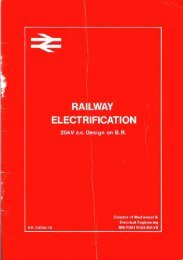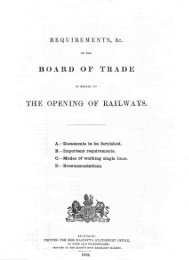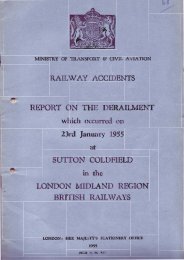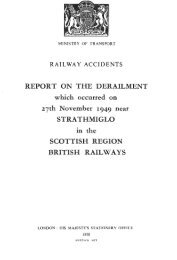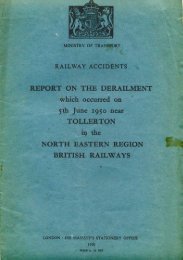R A I LT R AC K - The Railways Archive
R A I LT R AC K - The Railways Archive
R A I LT R AC K - The Railways Archive
You also want an ePaper? Increase the reach of your titles
YUMPU automatically turns print PDFs into web optimized ePapers that Google loves.
sustaining<br />
We have concluded<br />
from our analysis<br />
that whole-life costs<br />
of signalling assets<br />
are optimised<br />
through targeted<br />
renewals rather than<br />
renewal of entire<br />
installations<br />
38<br />
4.4 continued<br />
Renewals work is car ried out in accordance with Standards,<br />
to provide W10 gauge and 25.4-tonne axle-weight capacity.<br />
<strong>The</strong>se standards are regular ly updated to reflect best<br />
practice and to take into account developments in other<br />
industries.An important means of improving the<br />
effectiveness with which structures renewal work is<br />
performed is to combine packages of structures work<br />
together with renewal and repair activities performed on<br />
other assets.<br />
We are pursuing various opportunities to reduce the<br />
whole-life cost of renewal.Among them are standardised<br />
designs which can be constructed more cheaply, and the use<br />
of polymers both as structural members and as corrosion<br />
protection.We are intensifying our pursuit of lower-cost<br />
solutions.<br />
Signalling renewals. Our policy and strategy on<br />
signalling equipment renewals have developed over the past<br />
three years. We have concluded from our analysis that<br />
whole-life costs of signalling assets are optimised through<br />
targeted renewals rather than renewal of entire installations.<br />
We are working,therefore, to reduce signalling renewals<br />
costs significantly by ensuring that the scope of the renewals<br />
work is optimal and fully justified.<br />
We use a structured and numerate means of assessing<br />
asset condition,together with a national expert review<br />
process which ensures that our renewal plans are robust,<br />
justifiable, and nationally consistent. We are refining the<br />
processes by which we determine the appropriate and<br />
precise scope of the work in each case.This will enable us to<br />
target renewals of individual components or complete<br />
installations as appropriate, thus avoiding premature renewal<br />
of parts of installations,and ensuring that existing assets are<br />
used to the fullest possible extent.<br />
This emphasis is likely to lead to smaller and less costly<br />
renewal schemes targeted at those parts of the system that<br />
are approaching the end of their useful life. Many of the<br />
technology changes that we are already implementing as<br />
part of our overall signalling strategy are well suited to this<br />
type of work,particularly for extending the life of many of<br />
the installations of the 1960s and 1970s which are prone to<br />
localised degradation.<br />
<strong>The</strong>re will still be cases,however, where the best option is a<br />
conventional wholesale renewal.This might be justified where<br />
we are able to enhance the network simultaneously by, for<br />
example, increasing capacity or reducing journey times,or<br />
reducing maintenance costs through the introduction of<br />
modern technology.<br />
We are working closely with our signalling suppliers to<br />
optimise our maintenance and renewal activities.Closer<br />
relationships are producing opportunities for innovation to<br />
drive productivity up and costs down.<br />
Long-term signalling strategy and Network<br />
Management Centres (NMCs). We are developing the<br />
new Train Control System (TCS) for initial application on the<br />
West Coast Main Line (WCML) in partnership with Alstom<br />
Signalling.<strong>The</strong> TCS will enable higher speeds,greater route<br />
capacity and better reliability at a lower whole-life cost than<br />
conventional signalling.<strong>The</strong> TCS is based on the European<br />
Rail Traffic Management System specifications being<br />
developed as the European standard for interoperable<br />
routes.<br />
<strong>The</strong> TCS comprises control centre computers which<br />
communicate continuously with trainborne computers via<br />
digital radio. Each train determines its position by a<br />
combination of odometry and fixed beacons (balises)<br />
mounted in the track.<strong>The</strong> central computer is aware of the<br />
locations of all the trains in its area,and computes safe limits<br />
for a train’s movements,which are then transmitted to the<br />
train and displayed to the driver. If the driver fails to react<br />
correctly to the instructions, the inherent Automatic Train<br />
Protection (ATP) system intervenes and applies the brakes.<br />
After the WCML, we are considering the deployment<br />
of the TCS on the East Coast Main Line and the Great<br />
Western Main Line – the next two longest-distance and<br />
highest-speed routes. We have also been able to<br />
demonstrate its potential for subsequent cost-effective<br />
application to some other routes.<strong>The</strong> strategy for rollout of<br />
the TCS across the network will be refined as the unit costs<br />
of implementation become clearer, and as we gain<br />
experience with the installation and operation of this new<br />
system.Our renewal activities,in the meantime, will aim to<br />
maximise the potential for future large-scale TCS installation<br />
by life-extending some current equipment where practicable<br />
so that the largest possible geographic and route area



